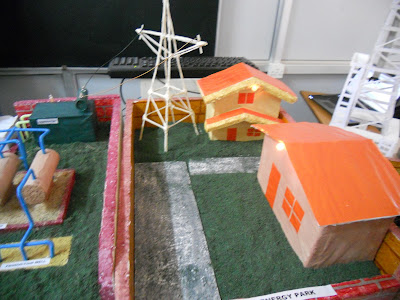Geo Thermal Energy-Science Exhibition 2012-Applied Geology, Kuvempu University.
Contact Address:
Dept of Applied Geology
Kuvempu University
Shankargatta
contact no: 9742567017
Geothermal energy is thermal energy generated and stored in the Earth. Thermal energy is the energy that determines the temperature of matter. Earth's geothermal energy originates from the original formation of the planet (20%) and from radioactive decay of minerals (80%).[1] Thegeothermal gradient, which is the difference in temperature between the core of the planet and its surface, drives a continuous conduction of thermal energy in the form of heat from the core to the surface. The adjective geothermal originates from the Greek roots γη (ge), meaning earth, and θερμος (thermos), meaning hot.
The heat that is used for geothermal energy can be stored deep within the Earth, all the way down to Earth’s core – 4,000 miles down. At the core, temperatures may reach over 9,000 degrees Fahrenheit (5000 degrees Celsius). Heat conducts from the core to surrounding rock. Extremely high temperature and pressure cause some rock to melt, which is commonly known as magma. Magma convects upward since it is lighter than the solid rock. This magma then heats rock and water in the crust, sometimes up to 700 degrees Fahrenheit (370 degrees Celsius) [2]
From hot springs, geothermal energy has been used for bathing since Paleolithic times and for space heating since ancient Roman times, but it is now better known for electricity generation. Worldwide, about 10,715 megawatts (MW) of geothermal power is online in 24 countries. An additional 28 gigawatts of direct geothermal heating capacity is installed for district heating, space heating, spas, industrial processes, desalination and agricultural applications.[3]
Geothermal power is cost effective, reliable, sustainable, and environmentally friendly,[4] but has historically been limited to areas near tectonic plate boundaries. Recent technological advances have dramatically expanded the range and size of viable resources, especially for applications such as home heating, opening a potential for widespread exploitation. Geothermal wells release greenhouse gases trapped deep within the earth, but these emissions are much lower per energy unit than those of fossil fuels. As a result, geothermal power has the potential to help mitigate global warming if widely deployed in place of fossil fuels
The Earth's internal thermal energy flows to the surface by conduction at a rate of 44.2 terawatts (TW),[33] and is replenished by radioactive decay of minerals at a rate of 30 TW.[34] These power rates are more than double humanity’s current energy consumption from all primary sources, but most of this energy flow is not recoverable. In addition to the internal heat flows, the top layer of the surface to a depth of 10 meters (33 ft) is heated by solar energy during the summer, and releases that energy and cools during the winter.
Outside of the seasonal variations, the geothermal gradient of temperatures through the crust is 25–30 °C (45–54 °F) per kilometer of depth in most of the world. The conductive heat flux averages 0.1 MW/km2. These values are much higher near tectonic plate boundaries where the crust is thinner. They may be further augmented by fluid circulation, either through magma conduits, hot springs, hydrothermal circulation or a combination of these.
A geothermal heat pump can extract enough heat from shallow ground anywhere in the world to provide home heating, but industrial applications need the higher temperatures of deep resources.[6] The thermal efficiency and profitability of electricity generation is particularly sensitive to temperature. The more demanding applications receive the greatest benefit from a high natural heat flux, ideally from using a hot spring. The next best option is to drill a well into a hot aquifer. If no adequate aquifer is available, an artificial one may be built by injecting water to hydraulically fracture the bedrock. This last approach is called hot dry rock geothermal energy in Europe, or enhanced geothermal systems in North America. Much greater potential may be available from this approach than from conventional tapping of natural aquifers.[21]
Estimates of the potential for electricity generation from geothermal energy vary sixfold, from .035to2TW depending on the scale of investments.[3] Upper estimates of geothermal resources assume enhanced geothermal wells as deep as 10 kilometres (6 mi), whereas existing geothermal wells are rarely more than 3 kilometres (2 mi) deep.[3] Wells of this depth are now common in the petroleum industry. The deepest research well in the world, the Kola superdeep borehole, is 12 kilometres (7 mi) deep.[35] This record has recently been imitated by commercial oil wells, such as Exxon's Z-12 well in the Chayvo field,Sakhalin.[36]
Contact Address:
Dept of Applied Geology
Kuvempu University
Shankargatta
contact no: 9742567017










No comments:
Post a Comment